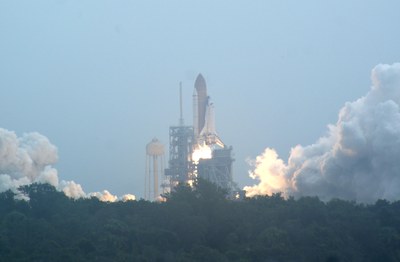The best of spacecraft, the worst of spacecraftDueling narratives at the end of the Space Shuttle eraby Andre Bormanis
|
| But like Thomas Edison, we can choose to view the Space Shuttle program not as a failure, but as an important (if somewhat frustrating) journey on the long road to eventual success. |
The first ten years of human spaceflight marked a period of breathtaking progress. For those of us growing up at that time, the Space Shuttle seemed, at first, to promise even more: a reusable space cargo plane that was leaps and bounds ahead of the relatively crude, throwaway rockets of the 1960s and ’70s. I vividly remember watching on television as Robert Crippen emerged from Columbia after its first flight in 1981, circling the orbiter on the runway at Edwards Air Force Base like a proud father, clearly excited, maybe even a little overwhelmed, by the potential of his spaceplane prodigy. Surely this magnificent machine and its siblings would soon enable hundreds, if not thousands, of people to live and work in space. And once the shuttle established a permanent beachhead in LEO, NASA could quickly turn its sights to Mars, the bright red apple of every space explorer’s eye.
We all know it didn’t work out that way, and we have a pretty good idea why. The budget available to develop and build the ambitious shuttle design was too small from the beginning. NASA made engineering comprises that kept development costs more or less under control, but this inevitably increased the operational expenses of the system, and compromised its reliability and safety. Rosy estimates for flight rates steadily fell through the 1980s, but the stubborn, almost pathological belief among NASA management that the shuttle was an operational, not an experimental vehicle, didn’t yield to reality until Challenger exploded on a cold January morning in 1986. Our dreams of routine Space Shuttle missions died with its heroic crew. From this perspective, the shuttle was clearly a failure. It failed to deliver what it originally promised: inexpensive, safe, routine access for humans and cargo to LEO.
But like Thomas Edison, we can choose to view the Space Shuttle program not as a failure, but as an important (if somewhat frustrating) journey on the long road to eventual success. It provided invaluable lessons in the logistics of managing complex, re-useable space systems; the development of advanced design tools, materials, and testing techniques; new life support technology and extensive EVA experience—the database is immense, and comprises a solid foundation for whatever comes next.
In addition to NASA engineers, entrepreneurs from many diverse backgrounds are now engaged in a race to achieve the promise the Space Shuttle was never able to deliver. Some have hundreds of millions of dollars and state-of-the art manufacturing facilities at their disposal; others work on shoestring budgets in their garages. Most will fail. Some will fail spectacularly, losing fortunes and possibly (well, probably) sacrificing lives. But if only one succeeds, it will be enough. After 9,000 attempts, Edison finally found the right material to make a durable filament for his electric lamp, and forever banished the night. When that breakthrough happens for human space exploration—and someday it surely will—I hope its architects give a nod of thanks to the Space Shuttle for making giant leaps in our understanding of how to get there—and just as importantly, how not to.
